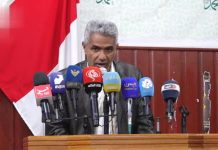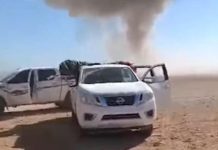Internally Displaced Are Struggling To Survive After Escaping Death
By Asma al-Mohattwari
Sada’a is a city under siege. Six months of Saudi-led coalition airstrikes day in and day out. Constantly, the citizens hear the scary sound of the attack aircraft that raise their worries and concern because they know what will happen later, a flash in the sky followed by the explosions’ sound caused by rocket fire.
Since the beginning of the Saudi Arabia led Arab coalition offensive against Yemen on May 25, 2015 and until today, the city of Sada’a has suffered the bulk of displaced people where they are found everywhere. Thousands of families fled their homes with their clothes only searching for a safe place to avoid what seems to many of them to be random bombing in civilian areas.
Women and children are the most affected, especially the poor that do not have any fault in the war and is of no reason to them. Fatima and her six children were displaced from Sada’a due to the bombing, which seemed indiscriminate to them. Fatima said, “I remember the first day of bombing, the aircrafts bombed thirty raids in one day. They madly bombed us, they even bombed cars, animals and stones,” said Fatima.
Fatima and her family were living in Razeh, border area, so they were affected also by the shelling from artillery.
They left their home and hid inside the mountains’ caves, but the bombing was so heavy, “I couldn’t stay anymore in Razeh. My children couldn’t sleep and all the night they put their hands in their ears to avoid hearing the aircrafts sounds. My husband had suffered a heart attack [stroke], I was afraid that his condition may deteriorate because of fear.”
Every day they woke up thinking that there is nothing alive, everything was burning and thanked Allah they are still alive. She was afraid that her husband, the heart patient, could suffer another TGI (transient cerebral ischemia) clot from his fear.
In the fourth month of bombing they decided to leave Sada’a and traveled to Sana’a because the bombing was not intensive as in Sada’a. To flee out of Sada’a was not easy as the Saudi-led coalition announced the area as an active military zone, with continuous bombardment on the homes and neighborhoods of local residents.
“We did not expect to get into Sana’a safely [due to bombardment] from the planes in the sky and cannon from the ground,” Fatima said with tears in her eyes.
Like all the displaced people, Fatima and her children arrived to Sana’a but they have no relatives to stay with. Everything was closed, only the schools were open to stay in. Fatima, her husband and six children were given a classroom to live in. The life there was so difficult; they shared one bathroom, kitchen and outside yard with hundreds of displaced people.
They couldn’t continue to live such a life, so they decided to find a house. A benefactor agreed to provide them a house with a small rent in Bani Hewat area in Sana’a. The home consisted of one room, bathroom and kitchen. “At least we can move [somewhere] comfortably. Until now we didn’t pay him any money. I am so afraid that he may send us out,” she added.
Fatima’s suffering and struggling to survive is one of 1.3 million people who have been forced to abandon their homes.
According to OCHA report on Yemen, many of the internally displaced people (IDPs) have experienced multiple displacements. Now 21 out of 22 governorates are hosting displaced people, with most of them coming from Aden, Al Dhale’e and Sada’a.
Not all displaced people are lucky like Fatima. Safia said that she did not find shelter for her and her kids only a classroom in an Althawra school, “it is better than living in the street.”
Safia’s family left her home after bombing destroyed a large part of her house and even if the war stopped, they have no home to go back to. “War destroyed our homes, killed our men and this classroom has become my home and its four walls is a shelter for my young children,” she added.
Since the conflict in Yemen escalated in late March, OHCHR has documented some 6,631 civilian casualties, including 2,112 civilian deaths, and 4,519 wounded (Sept. 2, 2015), with the actual number of civilian casualties are likely higher.
Also children bear the brunt of the crisis in Yemen. Rahiq is a child of 11. She escaped the rockets from Sada’a with her family. School was her only concern, “I wish the war [would] end and I could be back to my school, having exams and meet my friends and teachers.”
Unlike Rahiq, Malak, 9, said that she doesn’t want to go to school because she is afraid if she goes they may bomb it while being inside, “they bombed a school in our village before”.
According to UNICEF’s Sept. 3, 2015 report ‘Education Under Fire’, since March thousands of schools have closed, and many damaged leaving 1.8 million children in Yemen without an education. This is in addition to 1.6 million children who were out of school before the conflict escalated.
Displaced people are suffering the shortage of food and water. Nassera and her two daughters go to a remote area to bring water from the street, operated by a charity. “We are trying to eat one meal a day to save food for days of rest until the charities arrive to [help] us”, said Nassera.
Peter Maurer, the head of the International Red Cross (ICRC), visited Yemen for three days. He called the world to wake up and see the siege, destruction, hunger and killing of civilians in Yemen.
Maurer described the situation in Yemen as catastrophic and is getting worse, “goods have to arrive to Yemen urgently without any restrictions and facilitate the supply of rationed materials, water and medicines.”
In his statement in Geneva, Maurer said that after his three days visit to Yemen he found the situation is getting worse day after day, “the world should wake up and see what is happening in this country”. He was further quoted as stating to the Associated Press (AP), “So Yemen after five months looks like Syria after five years.”
Recently, Amnesty International has accused the Saudi-led coalition of aggression against Yemen by targeting densely populated areas and call for the United Nations to form an international commission to investigate the possibility of war crimes in Yemen.
In its report, Amnesty International said that the air strikes carried out by the military coalition on Yemen that left a bloody series of civilian victims. “Eight attacks by the coalition during June and July caused 141 dead people, mostly women and children. The attacks targeted the populated areas with non-military targets”, the report added.
Much of the international community was not fair in reporting the unfolding of the Yemeni tragedy. United Nations Watch organization said that the High Commissioner for Human Rights (OHCHR) is supposed to be non-political and respect the highest standards of integrity in its report about the crimes committed by the Saudi-led coalition in Yemen since March.
The report that was published on the UN Watch website said of the other United Nations humanitarian organizations’ set agendas and issued reports on Israel’s crimes in Gaza and ignored the war crimes in Yemen.
The report alluded to the need to form a committee to investigate allegations of Saudi’s crimes against Yemeni civilians, the same as the committee investigated allegations of Israel’s crimes against civilians in Gaza.
Bombing is targeting all the governorates, especially Sada’a, Taiz, Aden and now Sana’a. Some citizens left their homes to escape the bombing, some refused to leave and prefer to risk dying in their homes and others are under continued bombing because they didn’t have money to move.
Bombing targeted everything, lives, institutions, markets, homes, farms and animals. Yemenis are still struggling to live and waiting for the day of having an end for what seems to many civilians an injustice of war.
This report was first published by Sincere.Global in conjunction with National Yemen newspaper based in Yemen will produce series of articles and reports with more focused on women and children suffer on Yemen’s recent war-torn led by Saudi Arabia and Arab coalition.
NYN




















